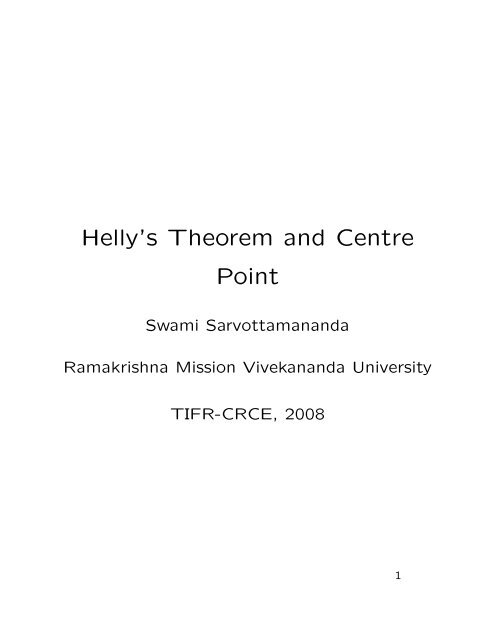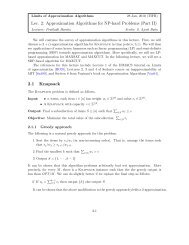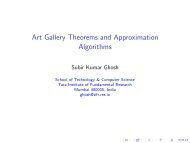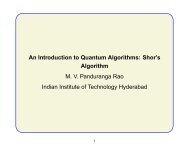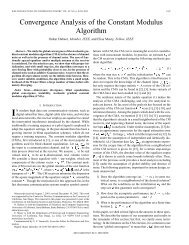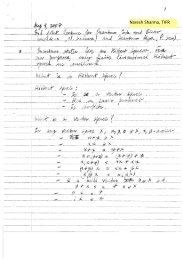Helly's Theorem and Centre Point
Helly's Theorem and Centre Point
Helly's Theorem and Centre Point
You also want an ePaper? Increase the reach of your titles
YUMPU automatically turns print PDFs into web optimized ePapers that Google loves.
Helly’s <strong>Theorem</strong> <strong>and</strong> <strong>Centre</strong><strong>Point</strong>Swami Sarvottaman<strong>and</strong>aRamakrishna Mission Vivekan<strong>and</strong>a UniversityTIFR-CRCE, 20081
Outline of the Talk• Motivation• Helly’s <strong>Theorem</strong>• Proof of Existence of <strong>Centre</strong>-point• Computing <strong>Centre</strong>-point• Summary2
Helly’s theorem (1923) <strong>and</strong> Radon’s theorem(1921) are equivalent <strong>and</strong> belong to the mostfundamental among the non-trivial results ingeometry. The concept of centre-point is ageneralisation of the concept of median for thepoints. For a set of points, it is a point suchthat the partitions of the set defined by it arereasonably balanced.1 min 2-1
Helly’s theorem is used to prove the existenceof centre-points where as Radon’s theorem isused to compute the centre-points in plane inlinear time complexity. In three dimensions <strong>and</strong>above there exists an algorithm that yields anapproximate centre-point in linear time thatuses Radon’s theorem extensively. There areanalogous results to Helly’s <strong>and</strong> Radon’s forgeneralisations of configurations <strong>and</strong> arrangementssuch as circular sequences <strong>and</strong> pseudolinearrangements.In the talk we shall prove the Helly’s theorem,use it to prove the existence of centrepoint,<strong>and</strong> present some algorithms to computecentre-points <strong>and</strong> to check if a point iscentre-point.1 min 2-2
Motivation for <strong>Centre</strong> <strong>Point</strong>s• We all have a notion of centre.• Can we formalise the notion of centre?3
We can think of centre of almost every geometricobject. We perceive that there shouldbe a central localtion for everything.3 min 3-1
Various Notions of <strong>Centre</strong>• Like circumcentre of a triangle — minimisethe maximum distance to all points.• Like orthocentre/in-centre of a triangle —maximise the minimum distance to the exterior.Both these generalise badly. We need togeneralise the notion of median of n values.4
Like there is a central place in China whichis farthest from the sea in any direction. Itsdistance to Indian Ocean, Pacific Ocean <strong>and</strong>Arctic Ocean is same.In 1-dimension both the notions generalise tothe mid-point of the two exterior point. Hencethese notions are not at all suitable. Even averageof n values captures more informationthan these.By the way, we usually use average because it iseasier to compute, but one or two very extremevalues can have adverse effect on average.5 min 4-1
Property We are Looking for in<strong>Centre</strong>• If possible, equal count/area/volume on allsides• Otherwise, balancing these as much as possible5
1. What do we mean by a side of any point?It is an ambiguous term.2. The second point is interesting because aswe will see it is not always possible to findcentre which balances perfectly.3. We can extend the result to non-euclideangemotry too, if a k-flat in k + 1-flat partitionsit into two (actually three).4. The notion of centre that we are lookingfor does not make sense in spherical (Riemannian)geometry where points are poles.All poles are in one side of a line (therearen’t any sides).7 min 5-1
Median is <strong>Centre</strong> in 1D1. We are not interested in distances — Butonly in number of points in either side.So, we do not worry about distance metric.2. Median partitions the set in two equal sizedhalves.6
The geometers do not like terms 1D, 2D, insteadthey prefer E d or R d to mention the d-dimensional space.9 min 6-1
<strong>Centre</strong> of Uniformly Distributedpoints in 2DHere centre is very nicely situated in the middle.Is it always possible to find a balanced centre?7
When we say that the centre is nicely situatedin the middle, we actually mean that every linepassing through it roughly divides the set inhalf.The same result will be had if the points aredistributed uniformly in a circle. Anything thathas to do with circle, we hope to have a goodcentre.The word balanced is not a technical term. Iuse it very loosely because we will see laterthat we will need to stretch the meaning ofthis term quite a bit.12 min 7-1
What do We mean by Balanced<strong>Centre</strong>Every line through centre divides the set inhalf.So, is it possible to find a balanced centre inall cases?8
In 2D it is always possible to find median of npoints that partitions in half. But it is not soin higher dimensions.15 min 8-1
Worst Case Distribution in 2D• Median divides points in equal halves.• But in 2D, the answer is NO.• <strong>Centre</strong> point dividing points only in onethird.9
Here we can only hope to find a centre-pointwhich guarantees only one-third of points ineither sides.In fact, here I have pointed out the centre accordingto the formal definition that we willgive later.What happens in still higher dimensions?18 min 9-1
Worst Case Distribution in 3D<strong>Centre</strong> point dividing points only in one-fourth.10
This is another kind of worst case distribution,but in 3D. The idea is similar, you put a groupof point on each vertex of a simplex <strong>and</strong> put afew points somewhere in the middle.Here, when we say that the centre divides theset of points in one-forth, what we really meanis that there exist a plane passing through thecentre which contains only one-fourth of thepoints on one side.Again dividing is taken in a loose sense.21 min 10-1
Definition of a <strong>Centre</strong>-pointA centre-point of a finite set of points, P , isa point such that every closed half-space containingit contains at least ⌈d+1 n ⌉ points of P .11
Equivalently, every hyper-plane passing throughthe centre-point contains at least ⌈ nd+1 ⌉ points.Mostly we will be looking at the discrete <strong>and</strong>finite set of points. So we will be interestedonly in the count. But it is possible to generalisefor other objects, if we try to balancearea, volume, etc.24 min 11-1
Remarks on the Definition of<strong>Centre</strong>-pointWe will concentrate only in E d , even thoughcentre-points exists elsewhere.What is important is the notion of half-space.Not all geometrical spaces may have this notion.12
We have already pointed out the case of noneuclideanspherical geometry case where pointsare poles <strong>and</strong> lines are equatorial chords.It is required that every hyperplane should createtwo half-spaces. So essentially it dividesthe space in three sets, two half-spaces <strong>and</strong>third the points in the hyperplane itself.26 min 12-1
Definition of a <strong>Centre</strong>-point inLower Dimensions1. In 1D — <strong>Centre</strong>-point is a median pointpartitioning set in half.2. In 2D — <strong>Centre</strong>-point partitions set in onethirdat least.3. In 3D — <strong>Centre</strong>-point partitions set in onefourthat least.13
The at least clause in 2D <strong>and</strong> 3D is importantbecause there are better cases when centrepointdivides the set more equally.27 min 13-1
Questions We can Raise• Do centre-points always exist?• Are they unique?14
Since we have already seen that in higher dimensionsthan 1 there may not exist any pointthat divides the set in half by every hyperplanepassing through it; it is natural to ask whetheror not same happens for ⌈ nd+1 ⌉.For the second question, we may safely saythat they may not be unique.29 min 14-1
The Answers• Do centre-points always exist?Yes. However, we need to supply a proof.• Are they unique?No. The examples above are sufficient toshow that there may be many centre-points,some better <strong>and</strong> some worse.15
We know that medians are not unique. Andfor a set of even number of points, there aremany points between two middle points whichpartition the set in equal halves.As we pointed out in case of better distributedpoint centre-points can do better.31 min 15-1
Task Before UsHow do we prove the existence of centre-point(at least in E d ) according to the definitiongiven previously?16
Hopefully, the proof may generalise easily toother spaces which admit concrete notions ofhalf-spaces.33 min 16-1
Helly’s <strong>Theorem</strong>We need to take help of Helly’s theorem toprove the existence of centre point.Helly’s <strong>Theorem</strong> Let S 1 , S 2 , . . ., S n be n ≥d + 1 convex sets in E d . If every d + 1 of thesets have common intersection than all the setshave a common intersection.17
That is to say that ⋂ ni=1S i is non-empty.35 min 17-1
Bound d + 1 is tight – I• Counter Example in d = 2 when we guaranteeonly every d sets have common intersection.18
The convex sets on the outside do not intersect.39 min 18-1
Bound d + 1 is tight – II• Same Example with d = 2 but with tightbound.19
You can check the case in 1 dimension, if everytwo intervals of several given intervals intersectthen all of them have a common intersection.42 min 19-1
Bound d + 1 is tight (SimpleCase) – III• Case of intervals in 1D.• <strong>Centre</strong> is between right-most left end-point<strong>and</strong> left-most right end-point.20
It is easy to prove that points that are in thecentral region shown in slide are in every interval.Otherwise there will exist two intervalswhich do not intersect.45 min 20-1
Proof of Helly’s <strong>Theorem</strong>• We need the help of Radon’s <strong>Theorem</strong> toprove Helly’s <strong>Theorem</strong>.• Actually Radon’s <strong>and</strong> Helly’s <strong>Theorem</strong> areequivalent.21
That is to say that Radon’s theorem can beused to prove Helly’s theorem <strong>and</strong> vice-versa.48 min 21-1
Radon’s <strong>Theorem</strong>Radon’s <strong>Theorem</strong> Let P be set of n ≥ d + 2points in E d . There exists a partition of P intosets P 1 <strong>and</strong> P 2 such that convex hulls of P 1<strong>and</strong> P 2 intersect.22
Radon’s theorem is a classic result from geometry.50 min 22-1
What is the Meaning ofRadon’s <strong>Theorem</strong>Example Instances of Radon’s <strong>Theorem</strong> in E 2 .23
We can give examples in 3D also. But, it isbetter to prove the result once for all.52 min 23-1
Sketch of the Proof of Radon’s<strong>Theorem</strong>• n ≥ d + 2 points are affinely dependent.∑ ni=1λ i p i = O, ∑ ni=1λ i = 0, O is origin, notall λ i = 0.• Let I 1 be the set of i for which λ i > 0 <strong>and</strong>I 2 be the set of i for which λ i < 0.• q 1 = 1 ∑λ i∈I 1λ i p i = − 1 ∑λ i∈I 2λ i p i = q 2 whereλ = ∑ i∈I 1λ i = − ∑ i∈I 2λ i• q 1 is in the convex hull of points p i , i ∈ I 1<strong>and</strong> q 2 is in the convex hull of points p i , i ∈I 2 .• Hence proved.24
It is enough if we appreciate that we partitiondepending on whether λ i is positive or not.56 min 24-1
Explanation of ProofCase of five points in 2D.• 1 2 p 1 + 1 2 p 2 − 1 3 q 1 − 1 3 q 2 − 1 3 q 3 = 0• q = 1 2 p 1 + 1 2 p 1 = 1 3 q 1 + 1 3 q 2 + 1 3 q 3• q is the Radon point.25
p i ’s are the points with positive λ’s <strong>and</strong> q i ’s arethe points with negative λ’s.60 min 25-1
Proof of Helly’s <strong>Theorem</strong>• The proof is by mathematical induction.• Let S 1 , S 2 , . . . , S i−1 , S i+1 , . . . , S N have a commonpoint p i (by induction hypothesis).• Consider P , set of p i ’s, which by Radon’stheorem cab be partitioned in two sets P 1<strong>and</strong> P 2 , convex hull of which intersect atq.• We can prove q belongs to every S i . Ifp i ∈ P 1 then since q is also in convex hullof p j ’s in P 2 , <strong>and</strong> also since all p j ∈ S i ,therefore q ∈ S i .• Hence proved.26
Yet another proof, this time for Helly’s <strong>Theorem</strong>If p i ∈ P 1 then since q is in convex hull of p j ’sin P 2 implies p j ∈ S i . Every point in other setis in S i .62 min 26-1
Explanation of ProofCase of four sets in 2D.• p 2 <strong>and</strong> p 4 (also p 3 ) are contained in S 1 .• q is in the convex hull of p 2 <strong>and</strong> p 3 .• q is in S 1 because S 1 is convex.• q is the common intersection point.27
Similar to S 1 we can prove that q belongs toall S i .65 min 27-1
Observation One for<strong>Centre</strong>-points• A half-space containing less than ⌈ nd+1 ⌉ pointswill not contain a centre-point.28
We can prove this by contradiction. If it containsa centre-point, we may find a half-spaceparallel to the half-space in question which containseven lesser points.Or otherwise also, it is contained in a halfspacewhich contains less than ⌈ nd+1 points,<strong>and</strong> therfore will not be a centre-point accordingto the definition that we have given.67 min 28-1
Observation two for<strong>Centre</strong>-points• <strong>Centre</strong> is intersection of all half-spaces containingmore than ⌊ ndd+1 ⌋ points. 29
Now we can take union of all such half spaceswhich do not contain at lease one centre-point.If we take complement of this set then we getthe set of all centre-points.69 min 29-1
Proof of <strong>Centre</strong> <strong>Point</strong>• Every d+1 half-spaces containing less than⌈d+1 n ⌉ points will not cover all points.• The intersection of their complements isnon-empty.• By Helly’s theorem the intersection of allsuch complements is non-empty.• Any point in this intersection satisfies thedefinition of centre-point.30
<strong>Centre</strong> can be equivalently seen as the intersectionof all half-spaces containing more than⌊ dnd+1 ⌋ points.71 min 30-1
Computation of <strong>Centre</strong>-<strong>Point</strong>• <strong>Centre</strong>-point is in the intersection of allhalf-spaces containing more than ⌊ dnd+1 ⌋ points.• Implies an O( n C d · n) algorithm to computea centre-point.• Can we do better?31
We can do better at least for plane. For higherdimensions, there is a good chance that thereis a linear time algorithm. But right now, wecannot do better than O(n d+1 ).73 min 31-1
Computation of <strong>Centre</strong>-<strong>Point</strong> inPlane• <strong>Centre</strong>-point in two dimension can be computedin linear time using Radon’s <strong>Theorem</strong>cleverly.32
This algorithm is analogous to the algorithmto find median of a set of points in plane. Itis a modification of prune <strong>and</strong> search class ofalgorithms.75 min 32-1
Computation of Approximation<strong>Centre</strong>-<strong>Point</strong>• Approximate centre-point in any dimensioncan be computed in linear time.33
The algorithm repeatedly substitutes a smallset of few extreme points with their Radonpoint.78 min 33-1
Checking <strong>Centre</strong>-<strong>Point</strong>• Problem of checking if a point is a centrepointin linear time in any dimension otherthan 1D is still not solved.In E 3 it can be done in O(n 2 ), in E 4 thefastest algorithm needs O(n 4 ) <strong>and</strong> for higherdimensions there is only straight-forwardmethod of computing all simplices whichis O(n d+1 ).34
More or less we have to construct every combinationof half-plane passing through the centrepointin question. Thus the complexity of thealgorithm is similar to the construction of <strong>Centre</strong>.80 min 34-1
A Generalisation of Helly’s<strong>Theorem</strong>• Let A of size at least j(d + 1) be a finitesubfamily of Kj d , the family of all sets of Edthat are the unions of j or fewer pairwisedisjoint closed convex set, such that theintersection of every j members of A is alsoin Kj d . If every j(d + 1) members of A havea point in common, then there is a pointcommon to all the members of A.35
Bound j(d + 1) is tight <strong>and</strong> cannot be furtherreduced.There is no common intersection for set oftwo intervals if every three of them intersectcommonly.We are relaxing the condition that each setneeds to be convex. Instead we say that eachset is disjoint union of j or less number of convexsets.82 min 35-1
Tverberg’s <strong>Theorem</strong> — AGeneralisation of Radon’s<strong>Theorem</strong>• Each set of (r − 1)(d + 1) + 1 or morepoints in E d can be partitioned into r subsetswhose convex hulls have a point incommon.36
Bound (r − 1)(d + 1) + 1 is tight <strong>and</strong> cannotbe further reduced.85 min 36-1
Summary• We saw the Helly’s <strong>Theorem</strong>• Next we proved existence of a <strong>Centre</strong>-point• Lastly, we sketched the computation of a<strong>Centre</strong>-point37
Further Reading• Jacob E. Goodman <strong>and</strong> Joseph O’Rourke(eds.), H<strong>and</strong>book of Discrete <strong>and</strong> ComputationalGeometry, 2nd edition, 2004• Herbert Edelsbrunner, Algorithms in CombinatorialGeometry, Springer Verlag, 198738
Thank You39


